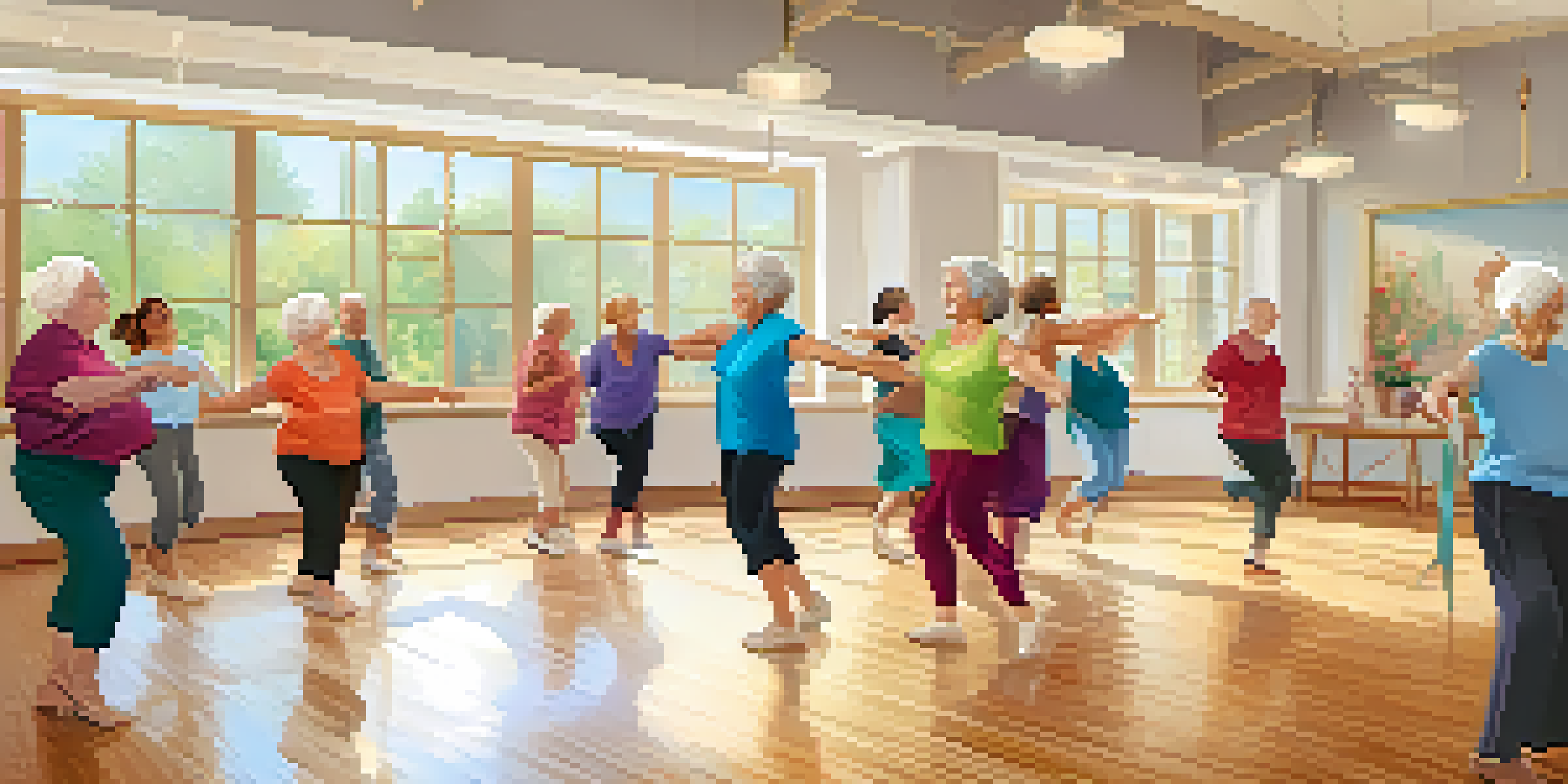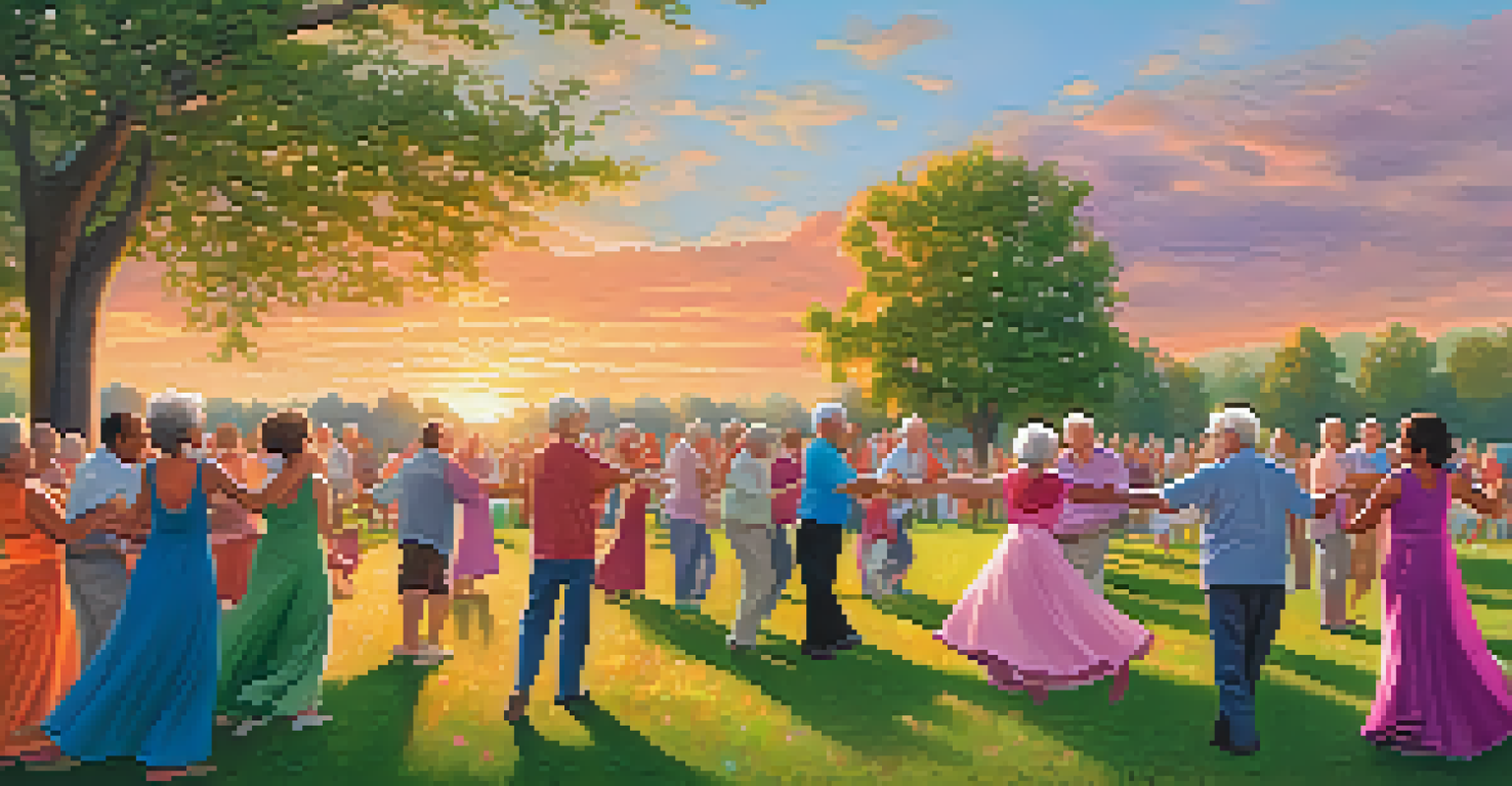How Dance Programs Improve Mental Health in Older Adults

The Connection Between Dance and Mental Well-Being
Dance is not just a form of artistic expression; it can significantly impact mental health, especially in older adults. Engaging in dance allows individuals to express emotions that they might find hard to articulate otherwise. This creative outlet helps to reduce feelings of anxiety and depression, fostering a sense of joy and accomplishment.
Dance is the hidden language of the soul.
Moreover, the rhythmic movements of dance can stimulate the brain, leading to improved cognitive functions. As older adults learn new dance steps, they engage their memory and enhance their coordination, which can help stave off cognitive decline. It’s fascinating to see how a simple dance class can serve as both a workout and a mental exercise.
In many communities, dance programs also offer social interaction, which is vital for mental health. Building friendships and being part of a group can combat loneliness, giving older adults a sense of belonging and purpose. This social aspect of dance makes it more appealing and beneficial than solitary forms of exercise.
Emotional Benefits of Dance for Seniors
Dance has a unique ability to evoke emotions, and for older adults, this can be particularly healing. Participating in dance can trigger joyful memories and feelings of nostalgia, which are essential for emotional health. It encourages individuals to reconnect with their past experiences, making them feel more integrated and fulfilled.

Additionally, the act of dancing releases endorphins, often referred to as 'feel-good hormones.' These natural chemicals can elevate mood and provide a sense of happiness that lingers long after the music has stopped. Just a few moments of dancing can transform a dull day into a vibrant one.
Dance Boosts Mental Well-Being
Engaging in dance helps reduce anxiety and depression, providing a joyful means of emotional expression for older adults.
Furthermore, dance provides a platform for self-expression, allowing older adults to communicate their feelings creatively. This can be especially important for those who may struggle with verbal communication due to age-related challenges. Sharing these experiences through dance can foster emotional resilience and promote a more positive outlook on life.
Physical Activity and Its Role in Mental Health
Engaging in physical activity is essential for maintaining mental health, and dance is an enjoyable way to stay active. Regular movement through dance can improve cardiovascular health, flexibility, and balance, which are crucial as we age. This enhanced physical health, in turn, contributes to better mental well-being.
The body says what words cannot.
Moreover, the act of dancing can help reduce stress levels. When older adults move to music, they often forget their worries, allowing for a temporary escape from daily challenges. It's a refreshing reminder that fun and fitness can go hand in hand, and this enjoyment can lead to a more positive mindset.
Additionally, participating in dance classes can encourage older adults to stay engaged in other physical activities. As they experience the benefits of dance, they may be motivated to explore other forms of exercise, further enhancing their overall health. This cycle of activity contributes to a healthier body and mind.
Social Connections Through Dance Programs
Social interaction is a fundamental aspect of mental health, and dance programs provide an excellent opportunity for older adults to connect. Joining a dance class means becoming part of a community, where friendships can flourish. These connections can help alleviate feelings of isolation and loneliness that many seniors face.
Group dance activities also foster a sense of teamwork and collaboration, which can boost self-esteem. Working together with peers to learn choreography or participate in performances can create a profound sense of accomplishment. This collective experience strengthens bonds and encourages a supportive environment.
Fosters Social Connections
Dance programs create community bonds that alleviate loneliness and promote a sense of belonging among seniors.
Moreover, the regular schedule of dance classes gives participants a reason to get out of the house. Having a routine can add structure to their day, making life feel more purposeful. The anticipation of socializing and dancing with others can be a powerful motivator for older adults.
Dance as a Tool for Cognitive Stimulation
Cognitive decline is a concern for many older adults, but dance can serve as a powerful tool for mental stimulation. Learning new dance moves and routines requires focus and memory, which can help keep the brain sharp. This mental engagement is crucial for maintaining cognitive function as we age.
Research shows that activities requiring coordination, like dance, activate multiple areas of the brain. This can lead to improved problem-solving skills and greater mental agility. When older adults engage in dance, they're not just moving their bodies; they're also exercising their minds.
Additionally, dance can facilitate neuroplasticity, the brain's ability to reorganize itself by forming new neural connections. The more complex the movements learned in dance, the more cognitive benefits can be gained. This is a compelling reason for older adults to lace up their dance shoes and hit the floor!
Incorporating Dance into Daily Life
Integrating dance into the daily lives of older adults doesn't have to be complicated. Simple activities, like dancing while doing household chores or following along with online dance videos, can make a big difference. These informal practices keep them active and encourage a fun approach to movement.
Community centers often offer classes tailored for seniors, making it easier to find structured dance opportunities. Joining a local dance group not only provides physical exercise but also fosters a sense of belonging. These classes can be a safe space where older adults can express themselves freely.
Enhances Cognitive Function
Learning dance routines stimulates the brain, improving memory and cognitive agility in older adults.
Moreover, families can encourage their loved ones to dance at home. Whether it's a family dance party or a slow dance in the living room, these moments can enhance emotional bonds and create cherished memories. It's a delightful way to spend time together while promoting mental health.
Success Stories: Real-Life Impact of Dance Programs
Many older adults have found transformative benefits through dance programs, and their stories are truly inspiring. For instance, a 75-year-old woman who joined a local dance class reported not only improved mood but also newfound friendships that enriched her life. Her journey highlights how dance can open doors to social connections.
Another success story features a retired veteran who struggled with PTSD. After participating in a dance therapy program, he experienced a significant reduction in anxiety and an increase in confidence. This illustrates how dance can be a therapeutic outlet for emotional healing.

These real-life experiences underscore the profound impact that dance can have on mental health. They remind us that, regardless of age, it's never too late to embrace movement and joy through dance. The stories of these individuals serve as a testament to the power of rhythm and community.